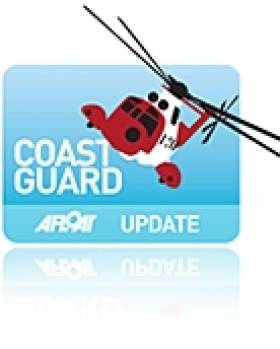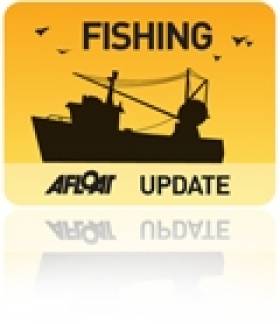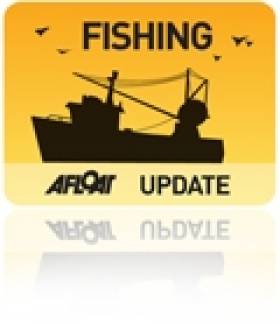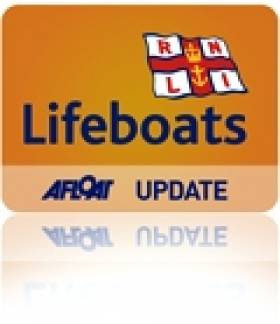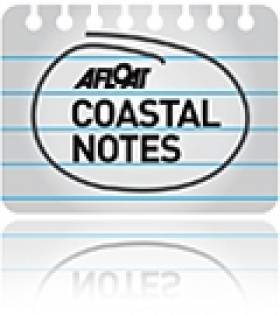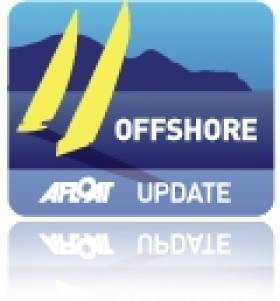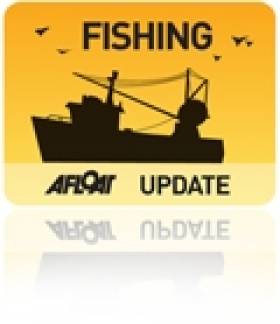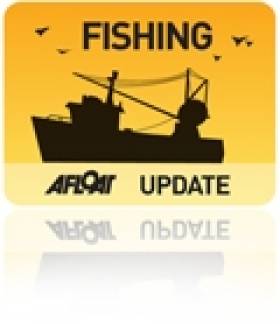Displaying items by tag: Fishing
Coastguard Airlifts Injured Fisherman In Atlantic Drama
#Coastguard - Waterford's Rescue 117 helicopter evacuated a fisherman with a crush injury to his leg from a trawler some 180km off the Irish coast yesterday afternoon (Wednesday 29 April).
The Irish Independent has dramatic video of the Irish Coast Guard medevac operation south-west of Kinsale, recorded by an Air Corps Casa as it provided search and rescue cover.
The fisherman was later transferred from Cork Airport to Cork University Hospital for treatment.
Fishing Vessel Skipper Charged Over Carlingford Lough Collision
#collisio – At a hearing today in the County Court Division of South Down, Lindsay Haugh, the Skipper of the fishing vessel Onward N336, was fined a total of £2,500 plus costs of £231 after pleading guilty for failing to keep a proper lookout, according to the UK's Maritime and Coastguard agency.
On 12th September 2014 at approximately midnight the fishing vessel Onward N336 was heading back from fishing grounds in thick fog to its home port of Killkeel when it collided with the Clipper Pennant, a Seatruck Ferries vessel at anchor off Carlingford Lough, Northern Ireland.
Lindsay Haugh, aged 44, from Killkeel pleaded guilty to unlawful conduct endangering ships, structures or individuals off Carlingford Lough, contrary to section 58 of the Merchant Shipping Act 1995, in that he omitted to monitor the recognised VHF channels, omitted to view radar in reduced visibility and omitted to keep a proper look out and as such omissions were deliberate or amounted to a breach, or neglect of duty.
In passing sentence His Worship District Judge King said, "Haugh fully accepted his responsibility and pleaded guilty at the first opportunity.
"Sea collisions are a serious responsibility. You as captain at sea are responsible for the boat, the crew and other persons at sea.
This is a serious matter and thankfully there was no serious damage or loss of life."
David Carlisle, Consultant Surveyor at the Maritime & Coastguard Agency (MCA) said: "This was a serious avoidable incident. Mr Haugh did not keep an effective watch in what was serious reduced visibility, nor did he observe the warning signals sounded from the Clipper Pennant."
Body Discovered In Search For Missing Fisherman Off Clare Coast
#Missing - RTÉ News reports that a body was found yesterday morning (Sunday 19 April) in the search for a missing fisherman off the Clare coast.
The search and rescue operation began in the early hours of yesterday morning after four people working with tractors in the oyster beds at Poulnaserry Bay got into difficulty when the tide came in.
Three of the fishermen were rescued by a local boat. RTÉ News has more on the story HERE.
Skipper Blames 'Submarine' For Irish Sea Trawler Incident
#Fishing - Was a fishing boat dragged backwards by a submarine in the Irish Sea?
That's what the crew of an Ardglass prawn trawler are saying after an incident yesterday afternoon (Wednesday 15 April).
As the Belfast Telegraph reports, skipper Paul Murphy says the 60-foot wooden-hulled trawler was some 18 miles off the coast, near the Calf of Man, when something snagged its nets.
“Without warning, were were stopped and pulled backwards very violently at around ten knots which is the top speed of the vessel. I really thought that was it," he says.
"It was fortunate that one of the steel ropes holding the net snapped or we would have been pulled under very quickly."
Murphy says the scary episode only lasted a few seconds, but still managed to cause thousands of pounds' worth of damage to his fishing gear – and alleges that the culprit was a submarine.
The Belfast Telegraph has more on the story HERE.
It wasn't the only drama in the Irish Sea yesterday, as a coastguard helicopter was scrambled to rescue three from a fishing boat that sank off Wicklow.
#RNLI - Arranmore RNLI saved two fishermen on Wednesday afternoon (8 April) after their 10m boat capsized off the Donegal coast.
A member of the public who was watching the fishing vessel from the shoreline raised the alarm at 2.50pm after he saw the boat capsize two miles south of Arranmore.
Arranmore RNLI’s boarding boat, which was already at sea with coxswain Anton Kavanagh and mechanic Philip McCauley on board, made its way to the scene.
Weather conditions at the time were described as blowing a gentle Force 2 to 3 wind but there was a heavy ground swell of three to four metres.
During their short passage, the volunteer lifeboat crew spotted and followed a track of fuel, and once on scene observed the wreckage of the stricken vessel. They then observed the two fishermen in the water approximately 300 yards from where the boat had capsized.
Both men were very cold when they were pulled from the sea and brought onboard Arranmore RNLI’s boat.
They were brought to Aphort Harbour, where they were made comfortable before being airlifted by the Irish Coast Guard’s Rescue 118 helicopter from Sligo and transferred to Letterkenny General Hospital.
Speaking following the callout, Anton Kavanagh said: "Both men are very lucky to be alive today and full credit must go to the member of the public who saw the boat capsize and raised the alarm, because the fishermen were not due back to shore for a couple of hours.
"We were delighted to be able to help and are glad that both men are safe and well."
#WestCork - A West Cork TD has welcomed the recent announcement of the near €18 million Fishery Harbour and Coastal Infrastructure Capital Programme.
As previously reported on Afloat.ie, the package announced last month by Marine Minister Simon Coveney is primarily aimed at safety, maintenance and development works at Ireland's six Fishery Harbour Centres.
Funded alongside electrical upgrading and more at Castletownbere Fishery Harbour Centre (€890,000) will be storm damage repairs works and improvements infrastructure at Cape Clear's North Harbour at a cost of nearly €2 million.
The funding allocation for these West Cork harbour sites was welcomed by local Fine Gael deputy Noel Harrington, who told the West Cork Times that the works at Cape Clear "will enhance the safety for those living on the island and the thousands who visit there each year."
Moreover, the Castletownbere works are "welcome and necessary in the busy port," he said, adding that he was confident further funding via Cork County Council would see greater investment in the West Cork coastal region.
American Sailor Rescued After 66-Day Survival At Sea
#Offshore - They say you should never leave port on a Friday – and following his rescue after more than two months lost at sea, American sailor Louis Jordan will surely be ruing that decision!
As TheJournal.ie reports, the 36-year-old beat the odds when he was picked up by a container ship some 200 miles off the coast of North Carolina yesterday (Thursday 2 April).
It brought an end to a 66-day ordeal for Jordan, who had departed Bucksport in South Carolina on Friday 23 January on a fishing trip, but ran into trouble when rough weather disabled both his boat and his communications gear.
While his family prepared for the worst, Jordan survived in the open sea by drinking whatever rainwater he could collect and fish he could catch. TheJournal.ie has more on this remarkable story HERE.
Elsewhere, the people of Sakhalin on Russia's Pacific coast have been devastated by the loss of at least 56 sailors after the sinking of a Russian trawler in the Sea of Okhotsk.
According to the Guardian, questions have been raised about whether the owner and international crew of the Dalny Vostok, based at Russia's largest island, had been cutting corners in their hunt for a big catch.
Owners of Dutch 'Supertrawler' Consider Appeal On €105,000 Fine
#SupertrawlerAppeal - The Irish Times reports that the head of the company that owns the world's largest trawler said on Sunday that his board is considering appealing a €105,000 fine imposed by an Irish court.
Diederik Parlevliet, managing director of Dutch firm Parlevliet and Van der Plas which owns super-trawler Annelies Ilena, complained the skipper was ordered to pay "a vastly unproportionate" sum for a €30 breach of the law.
That's what he claimed the amount of illegal fish was worth on the trawler, which is a half-metre longer than pitch in Croke Park.
The Irish Navy and Sea Fisheries Protection officers boarded the 144.6-metre Annelies Ilena off Tory Island in November 2013. For more on this story, click HERE
In addition to reading more by Lorna Siggins of The Irish Times (yesterday) who reflected on the arrest of the supertrawler, the former Irish owned 'Altantic Dawn' and the background to the current test case for EU fishery Law.
Largest Vessel: Dutch 'Supertrawler' Arrested by Naval Service
#SupertrawlerArrest - Lorna Siggins of The Irish Times reflects on the 922nd boarding by a Naval Service fishery patrol in 2013 which could have been a routine affair, but for the vessel's size and history.
The 144-metre Dutch-registered Annelies Ilena is seven times the tonnage of the patrol ship, LÉ Roisín (P51) – and multiple times that of the rigid inflatable (RIB) deployed by Lieut Cdr Terry Ward to inspect it.
The ship, formerly the Irish-registered Atlantic Dawn, is one of the world's biggest fishing vessels, the largest super trawler and the biggest detention by the Naval Service to date.
It was among a fleet of Dutch vessels working some 100 nautical miles northwest of Tory Island when approached by a joint Naval Service/Sea Fisheries Protection Agency (SFPA) patrol on November 22nd, 2013.
The team intended to board several in the fleet in the knowledge that such ships flying other EU flags were notoriously hard to inspect. If caught, it could also be a test case for EU fishery law.
"Vessels with the ability to catch fish on an industrial scale in waters under our jurisdiction, but which almost never land here, pose particular challenges to ensure regulatory compliance," SFPA chair Susan Steele said at the time.
Had it been 20 miles north, it would have been in Scottish waters.
It was detained and escorted to Killybegs, Co Donegal, on suspicion of "high grading", a practice initiated, ironically, in response to stricter EU quota regulations. It involves retaining the most valuable fish and throwing smaller, less valuable, fish which are still over the minimum size back into sea.
For supertrawlers, it can make the difference of several hundred thousand euro per trip.
For much more on this story, click here.
#TitBonhomme - RTÉ News reports that the families of two Egyptian fishermen who died in the Tit Bonhomme tragedy in West Cork three years ago last week settled their civil actions in the High Court.
Saled Mohamed Ibrahim Aly Eldin and Attia Shabaan were two of four Egyptian fishermen on the Union Hall fishing trawler that sank after running aground in rough seas near Adam's Rock at Glandore Harbour on 15 January 2012.
The incident took the lives of skipper Michael Hayes and fellow crew Kevin Kershaw, whose family settled an action in early 2013, and Wael Mohamed, whose family settled their own High Court action earlier this month.
The latter's brother Abdelbaky Mohamed was the only survivor, and gave testimony at the inquest into the incident in the summer of 2013, which returned verdicts of accidental death. RTÉ News has more on the story HERE.
Hayes' widow Caitlin Ní Aodha has since returned to the fishing industry and spoke to our own Tom McSweeney for his This Island Nation show in October last year.


























